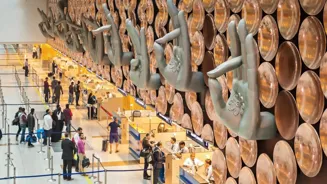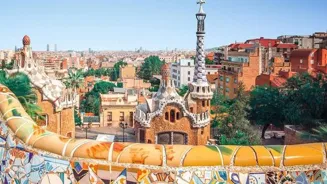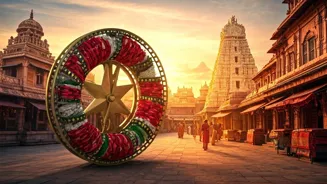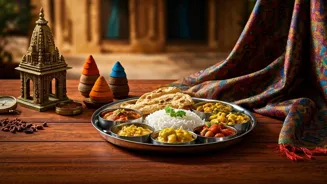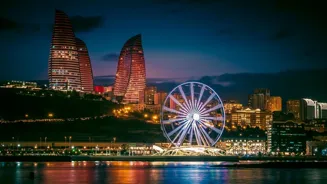Airports usually happen to be places of rush where people are hurrying to catch flights, announcements are echoing and luggage wheels are rolling across
shiny floors. Amidst all the hustle and bustle, at Delhi’s Indira Gandhi International (IGI) Airport, something makes travellers pause. No, it is not a duty-free shop or a luxury lounge, but a breathtaking wall of nine giant hand gestures: the mudras. Shining bright in copper against a golden backdrop, these mudras are not just decor pieces, they tell a story. A story of India’s culture and spirituality - something that still finds a place in our fast-paced modern lives.
A Grand First Gesture
Every traveller who steps into IGI Airport is greeted by this larger-than-life installation. The iconic wall has been designed by sculptor Nikhil Bhandari in collaboration with art collective Ayush Kasliwal Design Studio. The project was commissioned when Terminal 3 was being developed ahead of the 2010 Commonwealth Games. The main aim was to showcase India’s ethos to the world.The Meaning Of The Nine Mudras
Mudras, which translate to “gesture,” have been practiced for thousands of years in yoga, meditation and dance. Each mudra carries its own significance. These nine mudras at IGI are carefully chosen to represent India’s values, they include:- Abhaya Mudra (Gesture of Fearlessness): A raised right hand symbolizes protection and peace.
- Varada Mudra (Gesture of Generosity): The open palm facing downwards showcases compassion.
- Vitarka Mudra (Gesture of Teaching): The thumb and forefinger joined in a circle represents wisdom and guidance.
- Dhyana Mudra (Gesture of Meditation): Hands placed in the lap showcase serenity and spiritual awakening.
- Prithvi Mudra (Gesture of Earth): The joining of the ring finger and thumb symbolizes stability.
- Kartari Mukha Mudra (Scissor Gesture): Commonly seen in Indian classical dance, it symbolizes the separation of good and evil.
- Kapittha Mudra (Gesture of Strength): Used in Bharatanatyam, it represents power and devotion.
- Alapadma Mudra (Gesture of the Lotus): Hands shaped like a blooming lotus signify purity and beauty.
- Tripataka Mudra (Three-Part Flag Gesture): This gestures symbolizes victory.
India’s Popular Philosophy And An Instagram Sensation
The wall beautifully showcases India’s popular philosophy of “Atithi Devo Bhava” which translates to: the guest is god. By showcasing these gestures, IGI Airport subtly extends hospitality to millions of international visitors who land in Delhi each year.Beyond its spiritual depth, the mudra wall has also become a visual landmark in the digital age. From Bollywood celebrities to common traveller, almost every traveller passing through the spot definitely stops to take a photo in front of the installation. It has become one of the most Instagrammed airport spots in the world. In fact, creators have also started curating reels around the installation.
Even more than a decade after it was first unveiled, the mudra wall continues to mesmerize travellers. The next time you find yourself at IGI airport, look up at the wall of nine gestures. You will now understand that it is not just art; it is India greeting you with open hands and narrating a story that is as old as time and relevant even in today’s day and age.
